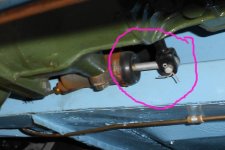Offline
I'm hoping this is easy. 
My Bugeye (with 1275, ribcase but otherwise all else "original" - including a new clutch) started to be fussy getting in/out of gear... and this came on rather fast. I was nearly stranded but pumped the peddle a bit and limped home.
Upon inspection, the fluid in the single square reservoir was down a bit (though not bad - and the brakes were fine), and there was no obvious leaking at the clutch master (or lines)).
Under the car the slave looked OK (at first), but I then noticed a single drop of fluid near the push-rod. When I squished the rubber boot inward a bit, out came a dribble of hydraulic fluid. :frown: It was incontinent!
Question: figuring duct-tape is out of the question :laugh: , can I easily swap out the guts (with a repair kit) WITHOUT removing the slave unit itself? Maybe I should pull the entire thing and evaluate the cylinder wall (and possibly hone it). Any tricks other than a pesky bleeding process at the end? Also, I notice that Moss mentions a different repair kit for a 948/1098 vs. 1275. I've got a 1275 but I think it's the original (square) combined master cylinder. Do I get the original for the 948/1098? https://www.mossmotors.com/Shop/ViewProducts.aspx?PlateIndexID=36484 (part #36 - but two are listed) I suppose I should just crawl back under there and see how the cylinder looks (bleed screw configuration - to see whether it's a 1275 or the 948/1098 style - right?).
Thanks.
My Bugeye (with 1275, ribcase but otherwise all else "original" - including a new clutch) started to be fussy getting in/out of gear... and this came on rather fast. I was nearly stranded but pumped the peddle a bit and limped home.
Upon inspection, the fluid in the single square reservoir was down a bit (though not bad - and the brakes were fine), and there was no obvious leaking at the clutch master (or lines)).
Under the car the slave looked OK (at first), but I then noticed a single drop of fluid near the push-rod. When I squished the rubber boot inward a bit, out came a dribble of hydraulic fluid. :frown: It was incontinent!
Question: figuring duct-tape is out of the question :laugh: , can I easily swap out the guts (with a repair kit) WITHOUT removing the slave unit itself? Maybe I should pull the entire thing and evaluate the cylinder wall (and possibly hone it). Any tricks other than a pesky bleeding process at the end? Also, I notice that Moss mentions a different repair kit for a 948/1098 vs. 1275. I've got a 1275 but I think it's the original (square) combined master cylinder. Do I get the original for the 948/1098? https://www.mossmotors.com/Shop/ViewProducts.aspx?PlateIndexID=36484 (part #36 - but two are listed) I suppose I should just crawl back under there and see how the cylinder looks (bleed screw configuration - to see whether it's a 1275 or the 948/1098 style - right?).
Thanks.

 Hi Guest!
Hi Guest!

 smilie in place of the real @
smilie in place of the real @
 Pretty Please - add it to our Events forum(s) and add to the calendar! >>
Pretty Please - add it to our Events forum(s) and add to the calendar! >> 

